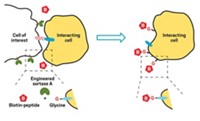Advertisement
Grab your lab coat. Let's get started
Welcome!
Welcome!
Create an account below to get 6 C&EN articles per month, receive newsletters and more - all free.
It seems this is your first time logging in online. Please enter the following information to continue.
As an ACS member you automatically get access to this site. All we need is few more details to create your reading experience.
Not you? Sign in with a different account.
Not you? Sign in with a different account.
ERROR 1
ERROR 1
ERROR 2
ERROR 2
ERROR 2
ERROR 2
ERROR 2
Password and Confirm password must match.
If you have an ACS member number, please enter it here so we can link this account to your membership. (optional)
ERROR 2
ACS values your privacy. By submitting your information, you are gaining access to C&EN and subscribing to our weekly newsletter. We use the information you provide to make your reading experience better, and we will never sell your data to third party members.
Biological Chemistry
New technique turns on specific kinases in mice
Genetic engineering, amino acid mutagenesis, and bioorthogonal chemistry combine to target kinase of choice
by Stu Borman
May 6, 2016
| A version of this story appeared in
Volume 94, Issue 19

A simple new technique turns on the enzymatic activity of specific native kinases in living cells and animals. The strategy could help elucidate the roles kinases play in cell signaling and diseases such as cancer.
Human cells make and use more than 500 types of kinases. Because of the structural similarities among them, it is hard to deactivate specific kinases with small molecules. Methods exist to turn on kinases selectively, but they produce kinases with modified structures, which may not function in the same way as the native enzymes.
Lysine is present in all kinase active sites. Peng Chen of Peking University and coworkers engineer cells in culture and in animals to incorporate a trans-cyclooctene-derivatized version of lysine in the active sites of specific kinases. This blocks the enzymes’ activity. They then inject a bioorthogonal cleavage reagent to remove the trans-cyclooctene group, restoring native kinase activity. They demonstrated the technique in cell culture and in mice on the kinase Src, which has been associated with certain cancers (ACS Cent. Sci. 2016, DOI: 10.1021/acscentsci.6b00024).
“This elegant new method shows great promise for controlling kinase action in complex environments,” comments signal transduction specialist Philip A. Cole of Johns Hopkins University.



Join the conversation
Contact the reporter
Submit a Letter to the Editor for publication
Engage with us on Twitter